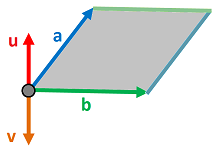This site is being phased out.
Hodge duality of multivectors
Even when the the meaning of the dual cell is clear, the question remains about its orientation. We discuss the Hodge duality of multivectors as the algebra behind the Hodge duality of cells.
Suppose $V$ is a module of dimension $n$.
An orientation of this space can be seen as a choice of a basis $\{p_1,...,p_n\}$ of $V$ and an $n$-vector $$p=p_1\wedge...\wedge p_n.$$
Recall the space of $k$-vectors in $V$ is the quotient of the product space $V^k$: $$\Lambda _k (V) := V^k / _\sim,$$ under the following anti-symmetry equivalence relation:
- $(v_1, v_2 ,..., v_k) \sim -(u_1, u_2 ,..., u_k)$ if the latter is the same as the former with two entries interchanged (or any other odd permutation is carried out).
We also know that $$\dim \Lambda _k= \binom {n}{k}.$$ Therefore, $$\dim \Lambda _k= \binom {n}{k} = \binom {n}{k} = \dim \Lambda _{n-k}.$$
Corollary. $$\Lambda _k\cong \Lambda _{n-k}.$$
But does this isomorphism have any geometric meaning?
Suppose this time $V$ is an inner product space.
Definition. Suppose our basis $\{p_1,...,p_n\}$ is orthonormal. The Hodge dual operator on $V$ of degree $k$ $$\star: \Lambda _k(V) \to \Lambda _{n-k}(V),$$ is defined by: $$\star (p_{s(1)} \wedge p_{s(2)}\wedge ... \wedge p_{s(k)}):= (-1)^{\pi(s)}p_{s(k+1)} \wedge p_{s(k+2)} \wedge ... \wedge p_{s(n)},$$ where $s$ is a permutation of $\{1, 2, ..., n\}$, and extended to all $k$-vectors by linearity.
Exercise. Prove that the operator is well-defined.
In particular, we have $$\star (p_1\wedge p_2\wedge ... \wedge p_k)= p_{k+1}\wedge p_{k+2}\wedge ...\wedge p_n.$$
For example, $$\star(1,0)=(0,1),\ \star(0,1)=-(1,0).$$ It's a counterclockwise $90$ degree turn! Furthermore, $$\star\big( (1,0,0)\wedge (0,1,0) \big)=(0,0,1),\ \star\big( (0,1,0)\wedge (1,0,0) \big)=-(0,0,1).$$ That's the cross product!
While the cross product is limited to this narrow situation in $3$-space, the Hodge operator applies to all dimensions.
Exercise. Demonstrate how the Hodge star matches the construction of cubes as products of edges and vertices.
Proposition. The star operator is an isomorphism.
Exercise. Prove the proposition. What is the matrix of this operator?
Definition. The inner product of multivectors $\langle \cdot,\cdot \rangle$ is given by $$\langle u,v \rangle = \det \left (\left \langle u_i,v_j \right \rangle \right ),$$ where $$u = u_1 \wedge \dots \wedge u_k, \ v = v_1 \wedge \dots \wedge v_k,$$ and extended to all $k$-vectors by linearity.
Proposition. $$u \wedge (\star v) = \langle u,v \rangle p,$$ where $p$ is the preferred unit $n$-vector, i.e., the orientation of $V$.
Exercise. Prove the proposition.
What about cells?
Theorem. In a tangent space of a simplicial or a cubical complex $K$, every (non-zero) chain is represented by a single (non-zero) multivector: there is a linear monomorphism: $$H:C_k(St_K(A)) \to \Lambda_k (T_A(K)).$$
